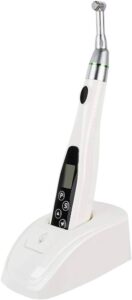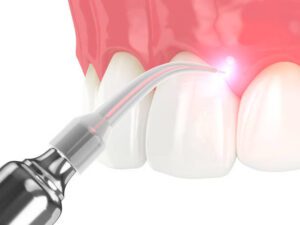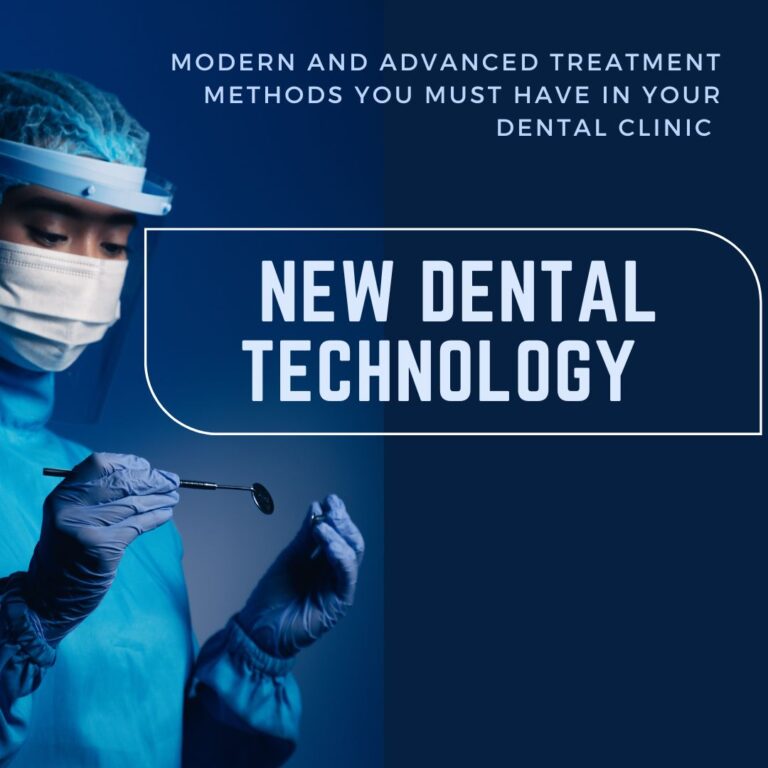Last updated on September 21st, 2023 at 07:58 pm
Embracing new dental technology is a forward-thinking approach that benefits both practitioners and their valued patients.
In today’s rapidly advancing world of dentistry staying ahead and integrating the latest dental equipment and the new dental technology is of paramount importance for dentists.
The incorporation of cutting-edge tools and innovations in dental clinics not only enhances the overall patient experience but also plays a significant role in improving patient care, diagnosis, and treatment outcomes.
This blog post delves into the significance of adopting new dental technology into dental practices and explores how these advanced equipment can revolutionize the way dentists deliver exceptional oral care.
Table of Contents
Significance of Incorporating New Dental Technology in Dental Clinics
Improved Diagnosis and Treatment Planning:
Latest Diagnostic Devices allow dental practitioners to visualize complex anatomical structures assisting in better treatment strategies (assess bone quality for implant placement, and plan orthodontic treatments with greater accuracy).
Enhancing Treatment Precision and Accuracy:
The use of advanced and latest dental technology help in achieving a systematic and precise treatment leading to improved treatment outcomes and patient trust.
Streamlining Workflow and Efficiency:
Dental clinics can streamline procedures with the help of new dental technology reducing turnaround time and increasing patient output thus promoting a more efficient practice.
Minimizing Invasive Procedures:
Dental technology offer a minimally invasive alternative to traditional dental treatments, resulting in reduced discomfort for patients and faster healing times.
Enhanced Patient Comfort and Safety:
Dental technology advancements focus on improving patient comfort and safety during dental procedures. These innovations aim to minimize pain and anxiety, making dental visits a more positive experience for patients.
Improving Patient Communication:
Dental devices like intraoral cameras and digital radiography help in visualizing the treatment areas. Dentists can explain dental conditions and treatment plans more effectively, empowering patients to make informed decisions about their oral health.
Data-Driven Decision Making:
Dental software and practice management systems allow for efficient record-keeping and data management.
Dental practitioners can access patients’ dental histories, treatment plans, and diagnostic images, facilitating data-driven decision-making .
As the field of dentistry continues to evolve, embracing the latest dental equipment and technology becomes imperative for dental practitioners.
By leveraging advanced dental technology, dental clinics can elevate patient care, improve diagnosis, and deliver exceptional treatment outcomes, ultimately building a strong foundation for successful and progressive dental practices.
1. Intraoral Cameras: For Better Patient Communication and Treatment Understanding
Intraoral cameras have revolutionized the way dentists interact with their patients, providing a powerful tool for patient education, treatment explanation, and documentation.
These small, handheld devices equipped with a camera lens allow dental practitioners to capture high-resolution images and videos of the oral cavity, providing patients with a clear and visual representation of their dental conditions.

New Dental Technology in Intraoral Lasers
1. Intraoral Camera with Macro Mode
These have enhanced magnification to detect cracks,fractures and caries.
2. Intraoral Camera with Fluorescence for Caries Detection
These IOCs have a unique feature of fluorescence that provides different colors for healthy, infected, affected active, and arrested dentin.
It provides a magnified view of the tooth along with an auto-fluorescent image of the carious enamel and dentin and helps in diagnosis, treatment (excavation) and monitoring of lesions and restorations.
3. Intraoral Camera with Composite Curing Light
These have LED curing light for curing composites.
(Courtesy)
The Role of Intraoral Cameras in Patient Education and Treatment Explanation
In America a recent survey conducted by Dental Economics found that 92% of practices use intraoral cameras regularly emphasizing their benifits .
Listing the role of intraoral cameras:
Visualizing Dental Conditions:
Intraoral cameras enable dentists to capture real-time images and videos of the patient’s teeth and gums, presenting a detailed view of their dental health.
Patients can see their dental conditions for themselves, making it easier to understand the need for specific treatments or procedures.
Clarifying Treatment Options:
Dental treatments can sometimes be complex, leading to confusion among patients.
Intraoral cameras facilitate a clear explanation of treatment options as dentists can visually demonstrate the benefits and potential outcomes of different procedures.
Engaging Patients in Treatment Decisions:
By involving patients in the treatment planning process, intraoral cameras empower them to make informed decisions about their oral health.
Patients are more likely to comply with treatment recommendations when they have a better understanding of their dental conditions and the proposed interventions.
Demonstrating Treatment Progress:
Throughout the course of treatment, intraoral cameras allow dentists to monitor and document changes in patients’ oral health.
This visual documentation serves as a valuable reference for both patients and dental practitioners thus ensuring that progress is on track.
Addressing Dental Anxiety:
Dental anxiety is a common concern among patients, often leading to dental avoidance.
Intraoral cameras help alleviate anxiety by demystifying dental procedures and providing patients with a more positive and transparent dental experience.
Improving Patient Compliance:
Patients who can visually comprehend the importance of oral health and the significance of proposed treatments are more likely to follow their dentist’s advice and adhere to recommended oral care routines.
Teledentistry
IOC can be used as a tele-dental device which can transmit the view of the oral cavity. It was shown to be an effective tool in diagnosis, timely oral health examinations, decreased dental visits, triage, and local treatment of many conditions of the oral cavity.
Intraoral cameras have emerged as a game-changer in modern dentistry, bridging the communication gap between dental practitioners and patients.
2. Digital Radiography: Advancing Dental Diagnosis with Reduced Radiation Exposure
Digital radiography has emerged as an innovative technology revolutionizing the field of dental diagnostics.
The adoption of digital radiography marks a significant advancement in dental diagnostics providing dentists with a safer, more efficient, and patient-friendly approach to image capture and interpretation.
The software includes advanced features like contrast adjustment, magnification and length measurement which make it extremely useful in dental treatments.

New Dental Technology in Digital Radiography
Artificial Intelligence-Aided X-Ray Interpretation
AI-Aided X-Ray Interpretation allows diagnosis of dental conditions using artificial intelligence.
Advantages of Digital Radiography
According to a Swedish study 98% of the dentists had made the transition to digital radiography;
Minimizing Radiation Exposure:
One of the most significant advantages of digital radiography is the substantial reduction in radiation exposure compared to conventional X-rays.
Patients and dental professionals alike benefit from lower radiation doses, ensuring safer and more frequent image capture when necessary.
Better Image Quality:
Digital radiography produces high-resolution images, offering supreme clarity and details.
Dentists can zoom in and manipulate the images for precise examination, assisting in the detection of even the most minute dental problem.
Faster Image Processing:
With traditional X-rays, the development process is time-consuming.
In contrast, digital radiography provides instantaneous image acquisition, eliminating the need for manual development and significantly expediting the diagnostic process.
Environmentally Friendly:
Digital radiography eliminates the need for film processing chemicals, making it an eco-friendly alternative to traditional X-rays and contributing to a greener dental practice.
Efficient Patient Diagnosis:
Digital radiography allows dentists to swiftly capture and review images, leading to quicker and more accurate diagnosis.
The immediate availability of images enables prompt treatment planning and execution.
Enhanced Patient Communication:
Dentists can share digital images with patients in real-time, enabling them to visualize their dental conditions and actively participate in the treatment decision-making process.
This fosters patient engagement and increases treatment acceptance rates.
Digital Storage and Accessibility:
Unlike traditional X-rays that require physical storage space, digital radiographs can be stored electronically.
This digital storage not only saves physical space but also allows for easy retrieval and access to patient records.
Teleconsultation and Collaboration:
Digital radiography facilitates seamless communication between dental practitioners, enabling remote consultation and collaboration on complex cases.
Dentists can seek expert opinions without the need to transfer physical X-rays, resulting in more efficient patient care.
With reduced radiation exposure, improved image quality, and streamlined diagnosis, digital radiography not only benefits dental professionals but also enhances patient experiences.
3. Apex Locators and Endodontic Motors: Elevating Root Canal Treatment Precision
Apex locators and endodontic motors play a crucial role in revolutionizing root canal treatment.
From achieving precise measurements to enhancing treatment outcomes, apex locators and endo motors have become indispensable tools in modern endodontics.

Role of Apex Locators
Accurate Root Canal Length Determination:
By using electronic signals, these devices help in determining the position of the apex accurately, reducing the risk of underfilling or overfilling during root canal treatment.
Reduced Radiation Exposure:
With apex locators, the need for multiple X-rays to determine the canal’s length is significantly reduced, thus minimizing patients’ radiation exposure and ensuring a safer treatment process.
Enhanced Efficiency and Time-Saving:
Apex locators expedite the root canal treatment process by providing real-time measurements.
Dentists can confidently proceed with canal instrumentation and obturation, leading to faster and more efficient treatment sessions.
Navigating Complex Anatomy:
Root canal systems can be intricate, with multiple canals and curved pathways.
Apex locators assist in navigating such complexities, enabling dentists to effectively clean and shape the entire canal system.
The Significance of Endodontic Motors
Precise and Controlled Instrumentation:
Endodontic motors offer adjustable settings for rotary instruments, providing dentists with control over the speed and torque during root canal procedures.
This precision ensures optimal canal shaping and minimizes the risk of instrument fracture.
Enhanced Cleaning and Debridement:
The versatility of endo motors allows dentists to use a variety of rotary files, enhancing the cleaning and debridement of the root canal space.
This results in more thorough removal of infected tissue and debris, promoting successful treatment outcomes.
Reduced Fatigue and Improved Ergonomics:
Endodontic motors alleviate the physical strain on dental professionals during prolonged root canal procedures.
The motor-driven rotary files reduce hand fatigue and improve overall ergonomics, contributing to the dentist’s comfort and focus during treatment.
Consistent and Predictable Results:
With the ability to control the rotational speed and torque, endo motors contribute to consistent and predictable treatment outcomes, ensuring uniform canal preparation and obturation.
Apex locators and endodontic motors have transformed root canal treatment, making it more accurate, efficient, and successful than ever before.
As a result, patients benefit from reduced treatment time, enhanced treatment precision, and improved treatment outcomes.
Endodontic device market was USD 1.75 billion in 2021 and expected to be at 2.55 billion by 2030 growing at a CAGR of 4.3%.
4. Dental Anesthetic Delivery Systems: Painless Injections and Enhanced Patient Comfort
Dental anxiety and fear are common concerns among patients, and these are thought to be the leading cause why patients avoid dental treatment.
The advancements in dental anesthetic delivery systems have ushered in a new era of painless injections and improved patient comfort.

Innovations in Dental Anesthetic Delivery Systems
Needle-Free Anesthesia:
Needle-free anesthetic delivery systems have emerged as a groundbreaking alternative to traditional injections.
These systems administer anesthetic through a high-pressure stream, eliminating the need for needles and significantly reducing injection discomfort.
Computer-Controlled Anesthesia:
Computer-controlled anesthesia delivery systems allow for precise control over the anesthetic flow rate and pressure, resulting in slow and steady injections.
Various different studies have concluded that CCLAD (Computer-controlled local anesthetic delivery) resulted in less pain or higher anesthesia success rates.
This controlled approach ensures a more comfortable and gradual numbing sensation, minimizing the abrupt discomfort associated with rapid injections.
Topical Anesthesia Gels and Patches:
Pre-treatment application of topical anesthesia gels or patches numbs the injection site, reducing the initial sting of the needle insertion.
This preliminary numbing enhances patient comfort during the actual injection process.
Moreover, dental practitioners can further enhance patient experiences by implementing effective communication, distraction techniques, and sedation dentistry to address dental anxiety and fear.
5. Dental Lasers: Revolutionizing Dental Procedures with Precision and Comfort
Dental lasers have a transformative impact on modern dentistry, offering a host of advantages including enhanced accuracy, reduced discomfort, and faster healing.
From soft tissue management to cavity preparation, the versatility of dental lasers has opened new possibilities for minimally invasive treatments and improved patient outcomes.

Versatility of Dental Lasers
Soft Tissue Management:
Dental lasers excel in soft tissue procedures, such as gum contouring, gingivectomy, and frenectomy.
The focused energy of lasers allows for targeted tissue removal, leading to minimal bleeding and reduced healing time.
Cavity Preparation:
Lasers have also gained popularity in cavity preparation, as they can accurately remove decayed tooth structure while preserving healthy enamel.
Unlike traditional dental drills, lasers reduce the risk of microfractures and minimize the need for anesthesia.
Periodontal Therapy:
Dental lasers aid in periodontal treatment by effectively decontaminating periodontal pockets and promoting tissue reattachment.
The gentle and selective nature of lasers preserves healthy tissue and encourages faster healing.
Root Canal Disinfection:
Lasers can be used to disinfect and decontaminate root canals, improving the success rate of root canal treatments.
Laser disinfection reaches areas that conventional methods may not effectively access, ensuring a more thorough cleaning process.
Advantages of Using Dental Lasers
Minimally Invasive Treatments:
Dental lasers allow for minimally invasive treatments, as they precisely target affected areas while preserving surrounding healthy tissues.
This approach reduces the need for extensive tissue removal, leading to faster healing and reduced post-operative discomfort.
Reduced Bleeding and Swelling:
The focused energy of dental lasers cauterizes blood vessels during soft tissue procedures, resulting in minimal bleeding.
Reduced bleeding and swelling contribute to a more comfortable recovery for patients.
Enhanced Patient Comfort:
Dental lasers are associated with minimal noise, vibration, and discomfort, which are common concerns for patients undergoing traditional dental procedures.
The reduced sensation of heat during laser treatments also adds to patient comfort.
Faster Healing and Recovery:
The precision of dental lasers promotes quicker healing, allowing patients to resume their normal activities sooner.
Additionally, laser therapy stimulates tissue regeneration, further expediting the healing process.
Incorporating Dental Lasers for Enhanced Care
Studies reveal that Lasers are frequently utilized because they cause less pain, require less anesthesia and avoid anxiety in patients who are afraid of dental drills and instruments. (Courtesy)
By integrating dental lasers into practice, dentists can offer their patients the benefits of minimally invasive treatments, reduced discomfort, and faster recovery times.
Dental practitioners can harness the potential of dental lasers by undergoing specialized training and certification. Understanding the various laser wavelengths and their applications is crucial for effective and safe laser usage.
Conclusion
In conclusion, adopting the latest dental technology and equipment is very important for modern dental clinics to provide exceptional patient care and stay ahead in the field of dentistry.
By integrating these advancements into their dental clinics, practitioners can elevate their practice, deliver exceptional patient care, and position themselves as leaders in the dental industry.
Read the Best Revenue Boosting Strategies for Dental Clinics
Want to know the Top 7 Wealthiest Dentists in the World? Click below
